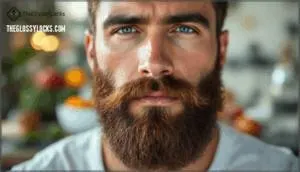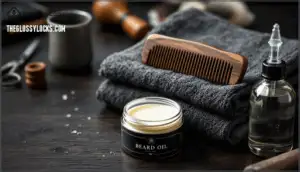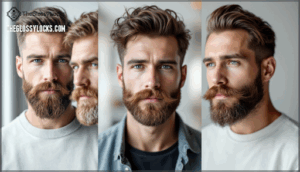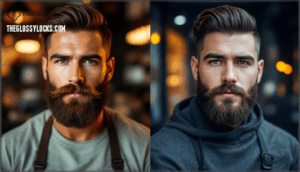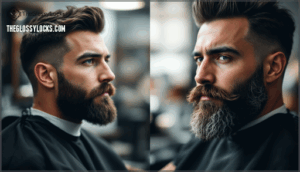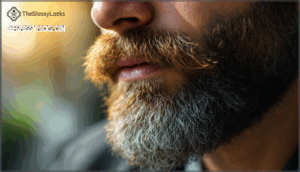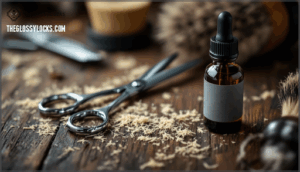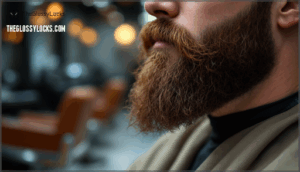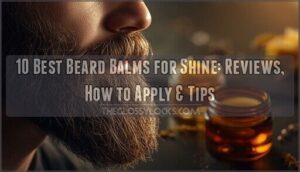This site is supported by our readers. We may earn a commission, at no cost to you, if you purchase through links.
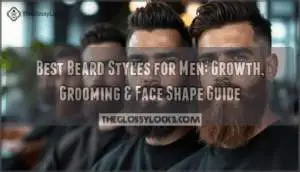
Whether you’re after a low-maintenance stubble or a statement-making Garibaldi, understanding how growth patterns, face shape, and grooming techniques work together will help you find the best beard styles for men that actually suit you. This guide breaks down what works, what doesn’t, and why.
Table Of Contents
- Key Takeaways
- Choosing Best Beard Style
- Beard Growth Tips
- Beard Maintenance Essentials
- Beard Styles for Face Shapes
- Minimal Maintenance Beard
- Thickening Your Beard
- Professional Beard Styles
- Beard Grooming for Beginners
- Advanced Beard Styling
- Frequently Asked Questions (FAQs)
- What are the best beard styles for men?
- What type of beard is best for black men?
- What is the best beard style for men in 2025?
- How to choose a beard style?
- What is the best beard sculpting style?
- What are the different types of beard styles?
- What are the most popular men’s beard styles?
- How do I choose the right beard style for my face shape?
- How long does it take to grow a full beard?
- What are some beard grooming tips for beginners?
- Conclusion
Key Takeaways
- Your face shape determines which beard style creates visual balance—round faces need vertical length like goatees, square faces benefit from softer edges, while oval faces work with nearly any style.
- Beard maintenance isn’t optional—consistent trimming, proper neckline definition, and daily application of quality oils and balms separate intentional grooming from neglect.
- Growth starts from within through protein intake for keratin production, testosterone-boosting compound lifts, and patience through the 2-6 month growth phases before making any trimming decisions.
- Professional beard styles require strategic choices based on workplace acceptance and maintenance commitment—77% of professionals find facial hair acceptable when well-groomed, but safety compliance and company policies still matter.
Choosing Best Beard Style
Finding the right beard style isn’t guesswork—it’s about understanding what works for your unique features. Your face shape, hair texture, and personal taste all play a role in determining which style will look best on you.
Let’s break down the key factors you need to think about before committing to a particular look.
Face Shape Considerations
Before choosing beard styles based on face shape, understand this: facial proportions determine what actually works. Your goal is creating visual balance, not following trends blindly. Mesoprosopic and leptoprosopic faces—both around 46% shape prevalence among men—benefit from different style correction approaches. Algorithm personalization in grooming apps now measures angles and lengths to recommend ideal matches, but the principle stays simple.
- Oval faces: Nearly every style flatters your balanced proportions—full beards, stubble, goatees all accentuate perceived masculinity.
- Round faces: Lengthen your chin with goatees or chinstraps to counteract width and sharpen definition.
- Square faces: Soften that strong jawline with anchor or Balbo styles, fuller at the chin but trimmed on sides.
- Rectangular faces: Add cheek fullness while keeping chin length controlled for proportion.
- Diamond/heart faces: Build jaw width with Garibaldi or ducktail styles to balance prominent cheekbones.
Hair and face shape work together—your growth pattern influences what’s actually achievable. To find the best look, consider your face shape before settling on a style.
Hair Type and Texture
Face shape sets the foundation, but your hair type and texture ultimately decide which styles you can pull off. Coarse or curly facial hair fills out bushy styles like the Garibaldi naturally, masking patchy growth through sheer beard density.
Fine or straight hair demands precision—clean edges and shorter lengths prevent wispy appearance. Growth direction creates styling challenges too; cowlicks or irregular patterns work better with natural, less structured looks than sharp Van Dykes.
Personal Style and Preference
Your texture sets the blueprint, but your personal style and preference write the final chapter. Individual expression drives the decision—a French Fork signals boldness while stubble suggests understated confidence.
Consider these alignment factors:
- Lifestyle alignment: Match grooming time to your schedule
- Age perception: Beard styles can shift how old you appear
- Cultural influences: Workplace norms shape acceptable facial hair
- Confidence boost: Choose what makes you feel powerful
- Face shape synergy: Personal style works within facial features
Mens fashion trends shift, but authentic self-expression outlasts them all.
Fashion fades, but owning who you are never goes out of style
Beard Growth Tips
Growing a beard that looks great starts from the inside out. Your diet, lifestyle habits, and willingness to wait all shape how your facial hair comes in.
Let’s break down the three key factors that set the foundation for solid beard growth.
Nutrition and Diet
Think of your beard as a plant—it needs the right fuel to flourish. Beard protein intake is critical since keratin requires about 0.8 grams per kilogram of body mass daily from lean meats, eggs, and legumes. Vitamin deficiencies in biotin, zinc, iron, and vitamin D cause patchy facial hair growth and thinning.
Load up on omega-3s from salmon and flaxseeds for improved beard health and density. Cut back on excess sugar and caffeine—they tank testosterone and spike cortisol, strangling hair growth.
Supplement risks are real; over-supplementation with selenium or vitamin A can trigger beard care disasters like hair loss. A balanced diet is key, and healthy hair growth depends on it.
Exercise and Testosterone
Testosterone isn’t just about muscle—it’s the silent architect behind every strand of facial hair you grow. Improve your hormonal balance, and you’ll discover fuller, denser facial hair growth that transforms your beard game.
Here’s how exercise types fuel your testosterone boost:
- Compound lifts like squats and deadlifts spike testosterone, triggering powerful beard growth
- HIIT workouts increase DHT production, the hormone that powers hair growth
- Resistance training builds muscle mass while strengthening follicle vitality
- Morning cardio improves circulation, delivering nutrients directly to your beard
Men’s grooming starts from within—consistent training equals consistent growth.
Patience and Time
Most beards fail before they even begin—not from genetics, but from the restless urge to shape what hasn’t yet become. Facial hair growth follows distinct beard growth phases, and skipping them sabotages everything. Setting expectations early protects your long-term commitment.
Trust the timeline:
- Growth stages take 2-6 months to reveal true potential
- Style evolution happens naturally as length increases
- Consistent routine beats impatient trimming every time
- Achieving desired beard length requires zero shortcuts
Beard Maintenance Essentials
Growing a beard is one thing, but keeping it sharp takes the right approach. Your maintenance routine determines whether your beard looks intentional or just forgotten.
Here’s what you need to focus on to keep your facial hair looking its best.
Trimming and Shaping
Your beard won’t shape itself, and that’s where intention meets execution. Start with clean lines along your beard neckline—one finger above the Adam’s apple works for most guys.
Use quality shaping tools and precise fading techniques to build beard symmetry. Trim your mustache to avoid lip coverage.
Maintain that clean neckline every few days, adjusting beard trimming frequency based on growth rate and your chosen style.
Washing and Conditioning
A clean beard starts with the right wash routine—skip this step, and you’re basically wearing yesterday’s lunch. Beard washing and conditioning keeps your facial hair soft and prevents the itch that drives most guys crazy. Use lukewarm water temperature—hot water strips essential oils your beard needs.
Here’s your wash routine:
- Wet your beard thoroughly with warm water.
- Apply beard shampoo and massage into the skin beneath.
- Rinse completely, then work in beard conditioner.
- Let it sit for two minutes before rinsing and patting dry.
Choose product ingredients without harsh sulfates. Wash frequency matters—two to three times weekly prevents dryness while keeping things fresh.
Oil and Balm Application
Think of beard oil and balm as the finishing coat on fine woodwork—without them, your facial hair splinters and frays into a mess nobody wants to touch. Apply beard oil daily for hydration and even distribution through damp facial hair. Beard balm works when you need grip and styling control.
Warm a few drops between your palms, work through from roots to tips using proper absorption techniques. Check for skin sensitivity with any new beard products. Application frequency depends on your beard’s dryness—some guys need morning and night beard maintenance.
Beard Styles for Face Shapes
Your face shape is the secret ingredient to choosing a beard that truly works. The right style can sharpen your jawline, balance your features, and bring out your best look.
Let’s break down which beards complement oval, square, round, rectangular, and diamond face shapes.
Oval Face Shapes
If you’ve got an oval face, you’re working with the golden ratio of beard styling. Studies show 91% of men with this face shape can pull off nearly any beard style without throwing off their natural symmetry. The short boxed beard tops the list, favored by 42% of professional barbers for maintaining that balanced look. Don’t go too long on the chin, though—that’s the one trap to avoid.
Here’s what works best for maintaining symmetry and experimenting with styles:
- Verdi and Balbo beards add distinction while keeping your proportions intact
- Classic goatee offers adaptability without elongation risks
- Beardstache blends medium stubble with a defined mustache for modern edge
- Ideal beard lengths range from subtle stubble to full growth, depending on your facial features
You can test different beard styles and face shapes to find what clicks with your personal vibe. Just keep things proportional and you’ll nail it.
Square and Round Face Shapes
Square and round faces work best with beard styles that reshape your natural contours. For square faces, rounded full beards and circle beards are preferred by 54% of stylists—softening angles is the goal here.
Round faces benefit from ducktails or goatees that add vertical length, improving facial definition in 63% of cases. Avoid fullness on the sides, which can widen square faces by 12%.
The right approach to defining jawline and adding length brings real style satisfaction when you match beard styles for men to your face shape.
Rectangular and Diamond Face Shapes
Rectangular and diamond face shapes demand fuller, structured styles to balance proportions. Diamond faces benefit from fuller beards and wide box styles, reducing cheekbone prominence by up to 19%. Rectangular faces pair well with chin curtain and Garibaldi beards to balance length and jawline width.
Here’s your approach:
- Fuller beards soften angular features and widen narrow jaws.
- Wide box styles add structure at the jawline.
- Chin curtain styles create horizontal visual weight.
- Maintain trimming frequency every 2-14 days for definition.
Choosing beard styles for men with these face shapes means prioritizing facial hair that adds width, not length. Proper grooming transforms your look.
Minimal Maintenance Beard
Not everyone wants to spend hours in front of the mirror perfecting their facial hair. If you’re looking for styles that won’t chain you to a grooming routine, you’re in the right place.
Let’s look at beard options that keep you looking sharp without demanding your entire morning.
Stubble and Short Beard Styles
If you want a style that practically grooms itself, stubble and short beards are your winning move. Heavy stubble ranks highest in stubble attractiveness, giving you that rugged edge without constant upkeep.
Short beard styles like corporate stubble fit professional settings while keeping facial hair styles sharp. Growing stubble takes patience—let it develop for three to five days.
Shaping stubble with a quality trimmer defines your jawline. Short beard maintenance means quick touch-ups, not daily marathons.
Goatee and Mustache Styles
Short stubble works, but maybe you’re itching for something sharper. Goatee variations like the Van Dyke beard or anchor goatee add definition without demanding hours at the mirror.
Pair your goatee beard styles with mustache styles that complement your face shape. These facial hair combinations deliver bold impact with straightforward maintenance—trim weekly, shape your mustache with wax, and you’re set. Perfect for guys who want presence without the fuss.
Easy Trimming and Shaping
You don’t need a barbershop to nail your look—mastering trimming and shaping at home is simpler than you think. Start with a quality beard trimmer and use guards for consistent length. DIY trimming means control over your facial hair styling without booking appointments. Shaping techniques like defining your neckline and cheek lines create clean edges. Check symmetry tips by comparing both sides in the mirror. Stick to a maintenance schedule—trim weekly to keep beard styles for men sharp.
- Pick the right beard trimmer with adjustable guards for tool selection
- Define neckline two fingers above your Adam’s apple for symmetry
- Trim against growth direction, then with it for even results
- Set a weekly schedule to maintain your shape without overthinking
Thickening Your Beard
If you want a fuller, thicker-looking beard, you’re not stuck with what genetics handed you.
There are practical steps you can take to improve density and create the appearance of more volume.
Let’s look at what actually works—from what you put in your body to how you use your trimmer.
Hair Care and Nutrition
Thick facial hair care starts with fueling your follicles from the inside out. Protein intake builds keratin—the structural backbone of every strand—while zinc and iron aid cellular division and oxygen delivery to your beard roots.
Healthy fats from salmon and walnuts help absorb beard vitamins like A and D, critical for sebum production and follicle regeneration.
Hydration effects show up fast: dehydrated beards turn brittle and prone to breakage. Pair mineral balance with quality beard oil and consistent facial hair care for skin care that aids growth.
Skip the junk food—your beard maintenance routine deserves nutrient-dense fuel.
Styling and Trimming Techniques
Strategic trimming turns scraggly growth into a beard that commands respect and complements your natural features. Use fade techniques and scissor over comb methods to blend patchy zones into fuller sections. Beard detailing around your cheeks and defining neckline with a beard trimmer creates structure, while symmetry refinement through careful beard line up elevates your facial hair styling. Master these facial hair grooming techniques and trimming becomes second nature.
- Layer different lengths to add depth and mask thin spots
- Angle your neckline to improve jawline definition
- Trim upward strokes for natural texture and volume
Professional Beard Styles
Your beard needs to work with your life, not against it. The right professional style keeps you looking sharp without constant upkeep or raising eyebrows in meetings.
Let’s look at the styles that command respect in any workplace while staying true to your personal edge.
Classic and Timeless Styles
Some beard styles never fade—they just get better with time, like a well-aged whiskey or a vintage leather jacket. The Classic Full Beard brings rugged masculinity that commands respect in any boardroom. Goatee variations, including the Van Dyke Beard and Circle beard, offer refined sophistication with a pointed chin presence. The Chin strap defines your jawline with precision, while a Chevron Mustache adds bold character. These styles work because they’re adaptable and universally flattering.
| Style | Best For | Maintenance |
|---|---|---|
| Full Beard | Executive presence | Weekly shaping, daily oil |
| Goatee Beard | Defined features | Precise edges, trim biweekly |
| Van Dyke | Distinguished look | Mustache wax, careful trimming |
Modern and Trendy Styles
Today’s beard game isn’t about following rules—it’s about breaking them with intention. The Beardstache Style pairs heavy stubble with a bold mustache for that relaxed vibe. Tapered Beards fade seamlessly into skin, giving you sharp, modern lines. Wild Beards embrace natural texture and volume—no apologies needed. Modern Goatees and Balbo Variations add focal points without overwhelming your face.
These trending beard styles prove that popular beard styles for men blend personal expression with contemporary facial hair trends.
Industry and Workplace Considerations
Workplace acceptance of beard styles has shifted dramatically—77% of professionals now find facial hair acceptable if well-groomed. Beard styles for professional men signal masculine appearance and confidence when trimmed strategically for beard styles and professional settings.
Your professional look depends on maintaining neat edges and proper mens grooming habits. Safety compliance matters in healthcare and industrial roles where OSHA requires clean-shaven faces under respirators.
Religious accommodation and the CROWN Act protect your rights in 21 states against beard discrimination. Check grooming policies before interviews, though 63% of men keep facial hair anyway.
Beard Grooming for Beginners
Starting your beard journey doesn’t have to feel overwhelming. Master a few key techniques and understand what works for your facial hair and what doesn’t.
Let’s break down the essentials that’ll set you up for success from day one.
Basic Trimming and Shaping
Trimming your beard without a clear plan turns maintenance into a guessing game—one that rarely ends well. Start with neckline definition—place two fingers above your Adam’s apple and trim everything below. Your cheek line should follow your natural growth pattern, removing strays without cutting too low. Use trimmer guards to maintain even length, working from longer to shorter settings.
Here’s your essential trimming checklist:
- Clean your beard trimmer before each use
- Define your neckline first for structure
- Shape your cheek line with precision
- Perform a symmetry check from both angles
- Apply scissor techniques for flyaways
Regular beard maintenance tips prevent uneven patches. These shaving tips and beard styling fundamentals keep your look sharp between barber visits.
Beard Care and Maintenance
Getting the trim right is only half the battle—keeping your beard healthy takes consistent care. Combat beard dandruff with proper beard brushing and quality styling products. Apply beard oil for itch relief and sun protection when outdoors.
Your beard maintenance and care routine needs these grooming product recommendations:
| Product Type | Key Benefit |
|---|---|
| Beard Oil | Hydrates and prevents itch relief |
| Beard Balm | Styling grip and conditioning |
| Beard Brush | Distributes oils, removes dandruff |
| Beard Wash | Deep cleans without stripping |
| Leave-in Conditioner | Daily moisture and protection |
Consistent beard maintenance tips beat sporadic deep-cleaning sessions every time.
Common Mistakes to Avoid
Even with the right products and routine in your corner, a few common grooming mistakes can sabotage months of effort. Over-grooming thins your beard faster than ignoring genetics allows it to fill in. Wrong products dry out your hair, while neglecting the neckline creates a sloppy silhouette. Uneven trimming throws off symmetry—your beard care depends on patience and precision.
Growing and grooming beards means respecting what you’ve got, not forcing what isn’t there yet.
Advanced Beard Styling
Once you’ve mastered the basics, it’s time to push your skills further. Elevated beard styling opens up bold, creative options that require precision, commitment, and confidence.
Here’s what you need to know about taking your beard to the next level.
Long and Elaborate Styles
Growing a beard past your jawline isn’t just about letting it ride—it’s about turning facial hair into a statement piece that demands attention and respect. Long beard styles like the Garibaldi Beard offer rounded fullness, while the French Fork splits dramatically at the chin for bold impact.
The Bandholz Beard requires serious upkeep but delivers untamed presence. Ducktail shaping adds pointed refinement, and Viking Beard aesthetics—complete with Viking Braids—channel raw, warrior energy that’s impossible to ignore.
Colored and Designed Beards
When your beard becomes a canvas, ordinary grooming rules don’t apply anymore. Beard dyeing lets you experiment with hair color—from subtle gray coverage to bold platinum tips that turn heads. Pair creative styling with beard designs like geometric patterns or fade work that complements beard and tattoos.
Color trends shift fast, so maintenance tips matter: touch up roots every three weeks, use sulfate-free products, and condition daily to protect dyed facial hair from drying out.
Advanced Trimming and Shaping Techniques
Mastering sophisticated techniques separates a groomed beard from a sculpted work of art. Precision detailing with a beard trimmer creates sharp beard line-up edges, while fade techniques blend your tapered beard seamlessly into your hairline. Focus on symmetry correction to balance uneven growth patterns, and maintain a clean neckline to frame your face properly.
Sophisticated methods include:
- Artistic shaping: Sculpt angles that complement your bone structure
- Beard sculpting: Layer different lengths for dimension and depth
- Clean neckline maintenance: Define boundaries with steady, deliberate passes
These skills transform ordinary grooming into professional-grade results.
Frequently Asked Questions (FAQs)
What are the best beard styles for men?
Your face is like a canvas—choosing from different beard styles for men means matching the right brushstrokes to your features. Popular beard styles work best when you consider face shape, facial hair texture, and maintenance requirements you can manage.
What type of beard is best for black men?
Black men’s facial hair generally grows in coarser patterns with unique texture. You’ll want styles that work with your natural growth patterns—short, well-defined looks like the goatee, circle beard, or tapered stubble address diverse hair texture and grooming needs while offering amazing style adaptability.
What is the best beard style for men in 2025?
Facial Hair Trends in 2025 lean toward personalization options and tech integration. Popular beard styles for men include heavy stubble, tapered beards, and beardstaches.
Mens grooming trends emphasize well-maintained styles over wild growth, reflecting influencer impact and style evolution in facial hair styling.
How to choose a beard style?
Your face shape is the north star when choosing facial hair. Match your beard styles to your bone structure—round faces need length on the chin, square faces want softer edges.
Factor in maintenance commitment, lifestyle alignment, job compatibility, partner preference, and current trends in men’s grooming.
What is the best beard sculpting style?
The best beard sculpting style depends on your face shape and the symmetry you’re aiming for.
Styling techniques, product selection, and sculpting tools help you define clean lines.
Maintenance frequency keeps facial hair sharp and balanced.
What are the different types of beard styles?
You can choose from dozens of options. Full beard and goatee variations suit most men. Van Dyke, chin strap, and ducktail beard offer distinct looks.
Face shape determines which short beard styles or long beard styles flatter you best.
What are the most popular men’s beard styles?
Stubble, goatees, and Van Dyke beards lead today’s men’s grooming trends, echoing a Renaissance reverence for facial hair styles. Celebrity influence drives style evolution, while trending beards like the Ducktail merge historical styles with modern appeal.
Match different beard styles to your face shape—popular beard styles work best when they complement your features.
How do I choose the right beard style for my face shape?
Your face shape determines which beard styles for men create balance. Round faces need vertical length on the chin—think goatees or ducktails. Square faces benefit from softer, fuller styles. Oval shapes work with almost anything, making style personalization easy.
How long does it take to grow a full beard?
How much time does your beard need to reach its full potential? Most men see a full beard emerge between 2-6 months, though genetics greatly influence beard growth.
Growth stages vary based on age factors and testosterone levels. Patchy growth is normal early on—stick with it.
The average timeline depends on your body’s unique hormonal balance and hair characteristics.
What are some beard grooming tips for beginners?
Start with essential tools: a quality trimmer, beard oil, and a comb. Wash your beard regularly, trim when needed, and apply oil to avoid itch.
Consistency beats complexity—keep your grooming tips simple, and your facial hair maintenance routine will become second nature.
Conclusion
Ironically, the hardest part of growing a beard isn’t the growth—it’s knowing when to stop. A well-chosen style respects your face shape, texture, and the time you’re willing to invest.
The best beard styles for men aren’t about trends or length alone. They’re about control, balance, and honest self-assessment. Shape with intention, maintain with consistency, and remember: every beard tells a story. Make sure yours isn’t written by neglect.
- https://theblacktux.com/blogs/news/top-beard-styles-by-state
- https://www.zeusbeard.com/blogs/zeus-beard-blog/top-12-beard-styles-to-rock-in-2025
- https://www.psypost.org/facial-hair-influences-trust-and-attractiveness-but-only-among-a-specific-group-of-men/
- https://tomshaircuts.com/2025/06/02/the-beard-report-hottest-beard-styles-making-a-statement-in-2025/
- https://www.gminsights.com/industry-analysis/beard-grooming-products-market

